This Skilhunt M150 v2 was providen by Skilhunt for review. Killzone Flashlights, a Skilhunt dealer for the US facillitated the arrangement. Here's the M150 at Killzone. Those are affiliate links to Killzone, and my affiliate coupon code "zakreviews" will get you 10% off.
For black friday weekend, code "BF30" takes 30% off Skilhunt products at Killzone. The M150 is also significantly discounted at Skilhunt's own website.
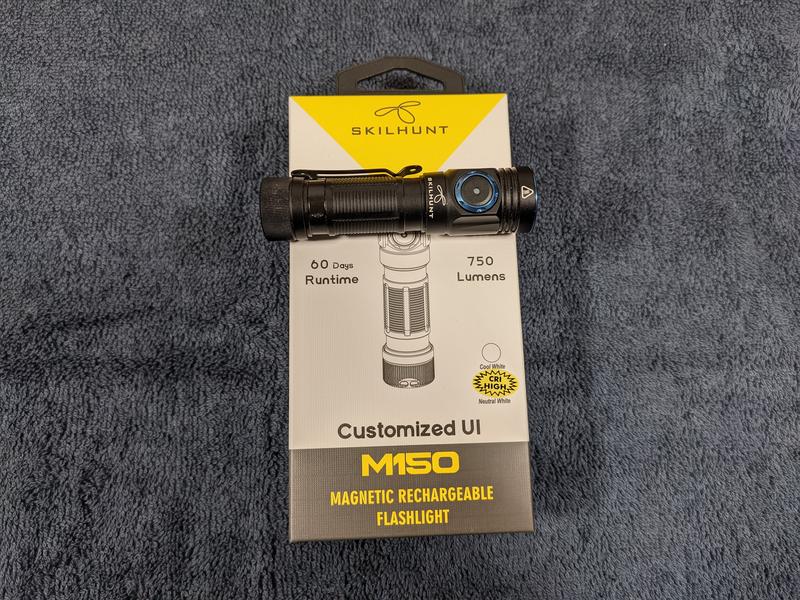
Overview
The M150 is a medium-small everday carry flashlight using a single AA battery, or a Li-ion rechargeable 14500 battery, which is included. It has USB-magnetic charging for the 14500, low-voltage protection for both battery types, and well-spaced modes for either. Output for the LH351D version is 666lm on 14500 and a respectable 220lm on AA. A number of competing lights do not support 14500 well, often losing their low modes and having poor regulation and mode spacing, and the risk of rapidly over-discharging unprotected 14500s. The M150 supports both battery types equally well, gaining output in higher modes as well as capacity with third-party 14500s holding about a Watt-hour more energy than the highest-capacity NiMH AAs.
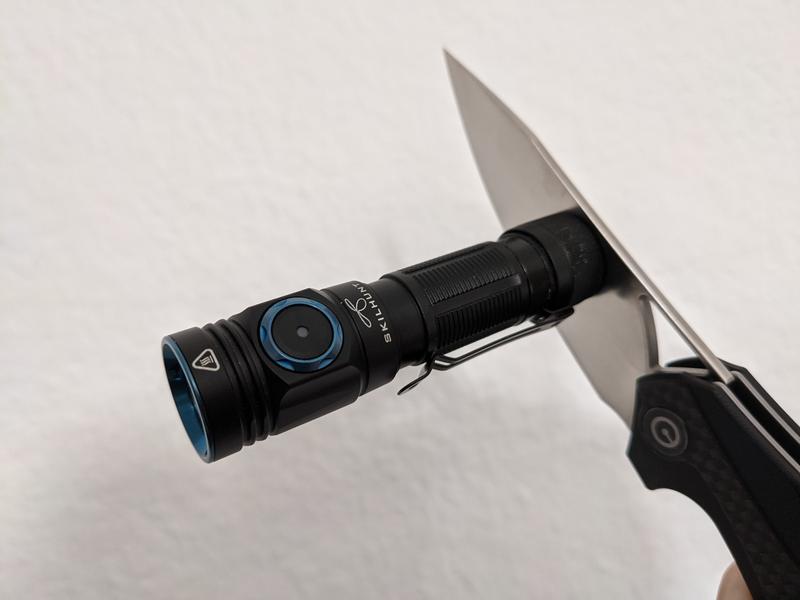
People don't traditionally cross-shop 1xAA and 1xCR123A lights especially often, as the CR123A previously offered higher performance, and many CR123A/16340 lights introduced in the past few years offer onboard charging. The latest 1000+ mAh 14500s match the capacity of a CR123A disposable under typical high-output flashlight loads, and exceed that of any 16340. Furthermore, the M150 matches the onboard charging of many of those lights while using a standard battery, unlike the proprietary battery found in the popular Olight S1R.
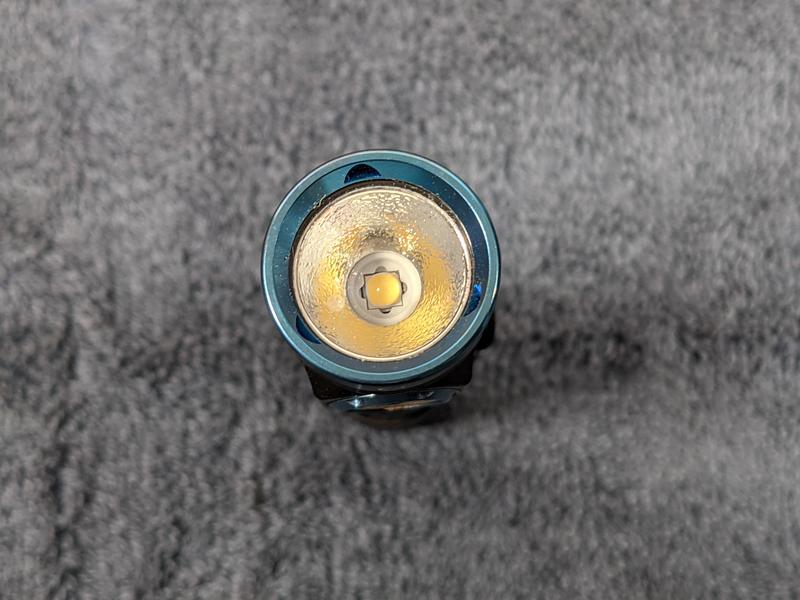
A criterion I've been applying to my subjective evaluation of any EDC light recently is how often I miss my Zebralight SC64c LE while carrying the light in question. That is, of course a considerably more expensive light with a larger battery. With the M150, it's very rare. I'd miss the larger 18650 battery if I needed high output for hours on end of course, but that's fairly rare for me in 2020, in part due to the pandemic. The only other issue that has made me wish I had my Zebralight instead of the M150 was an accidental activation, which the Zebralight's significantly more recessed switch would have prevented. In short, the M150 is absolutely an EDC favorite for me, and the light I reach for any time I want to carry something smaller than 18650.
| Specs | - |
|---|---|
| Battery | 1x14500 or 1xAA |
| LED | Samsung LH351D |
| Color rendering index | > 90 |
| Max output | 666 lm |
| Max throw | 99 m |
| Max sustainable output | ~310 lm |
| Max output at 50% battery | 622 lm |
| Best efficiency | 134 lm/W @ 162 lm (14500), 142 lm/W @ 141 lm (AA) |
| Candela per lumen | 3.64 |
| Length | 84mm |
| Head diameter | 21mm |
| Weight | 34g |
| Weight with battery | 56g (14500), 60g (NiMH) |
| Charging | USB to magnetic, battery charges in 100 minutes |
| Power from charge port | Yes, all modes (battery will discharge in high modes) |
| Power from charge port without battery | Yes, all modes (output of higher modes is less than with a battery) |
| Low Voltage Protection (LVP) | Yes, for both Li-ion and NiMH |
| Lockout | Mechanical and electronic |
Highlights
- High CRI
- Stable output (aside from stepdowns)
- 14500 and AA are equally well-supported
- Magnetic charging with a standard battery
- Comfortable UI in mode group B
- Slim profile
- Excellent efficiency given the size and CRI
Lowlights
- Loopover area of the pocket clip is too tight for thick pants
- Switch is a little too easy to press by accident
Details and technical analysis
Versions
The M150 offers a choice between a high-CRI neutral white Samsung LH351D, or low-CRI Cree XP-L2 in cool or neutral white. The older M150 v1 has a user interface with less configurability.
Accessories
The M150 includes a 14500 battery, magnetic charging cable, pocket clip, lanyard, spare O-rings, and user manual.
Modes and user interface
There are two different UIs: mode group A, and B. A resembles Skilhunt's older products, while B is similar to UIs used by Acebeam, Olight, and Thrunite, but with more modes, and user control over what modes are available. Skilhunt uses L, M, H, and T 2 and 1 to designate the modes, in order of lowest to highest. Blinking modes are designated S 1-3.
Mode Group A
| State | Action | Result |
|---|---|---|
| Off | Click | Last used (except Turbo, Strobe) |
| Off | Hold | Low (last-used of L1, L2) |
| Off | Double-click | Turbo (last-used of T1, T2) |
| Turbo/strobe | Click | Last used |
| On | Hold | Off |
| On | Double-click | Toggle sub-mode (e.g. M1, M2) |
| Any | Triple-click | Strobe |
| Off | Hold 2S | Lockout |
| Off | Hold 5S | Mode group B |
Mode group B
| State | Action | Result |
|---|---|---|
| Off | Click | Last-used (except T1, S) |
| Off | Hold | Lowest enabled |
| On | Hold | Cycle through steady modes (except T1) |
| Any | Double-click | T1 |
| Off | Triple-click | Last-used strobe |
| Strobe | Double-click | Cycle variable strobe, slow beacon, fast beacon |
| Off | Hold 2s | Lockout |
| Lockout | Hold 2S | Lowest enabled |
| Off | Hold 5s | Mode group A |
| On | Triple-click | Config |
Note that while the lowest mode can be saved into memory, it is not saved when accessed using the shortcut from off.
Loosening the head or tailcap a quarter turn locks out activation mechanically.
Config
In config, the light will cycle through all the modes other than T1. If enabled, the indicator light under the switch will be on, and if not, the light will be off. Click once to toggle the active mode. The cycle will continue until interrupted by either a long-press to save the current settings, or a triple-click to reset to factory defaults.
Output, runtime, and efficiency
Advertised performance is with the low-CRI XP-L2 LED, which will have different performance characteristics from the high-CRI LH351D. They are included for reference, but slight reductions in output and throw are to be expected in exchange for the greatly improved color quality. Runtimes may also be slightly different due to forward voltage. I have omitted the percentage of claim columns I usually include for this reason.
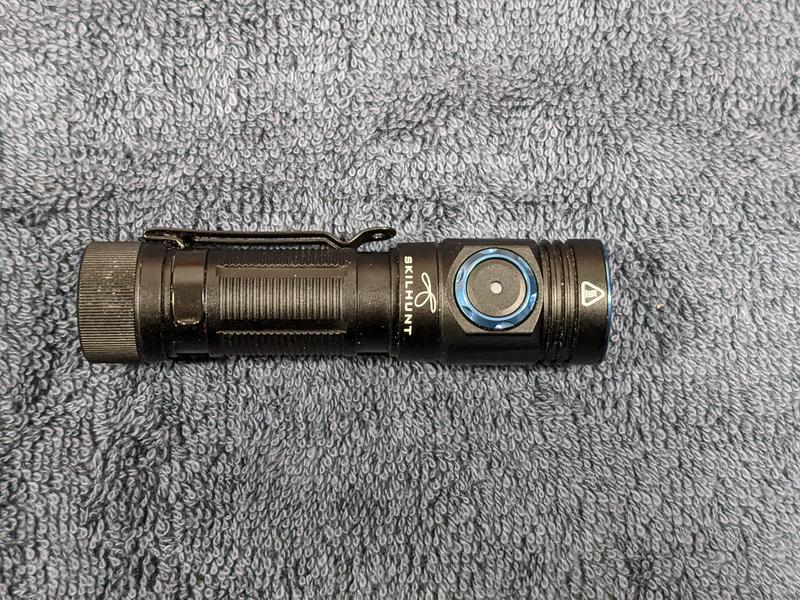
14500 battery
Advertised performance is using the included Skilhunt 800 mAh 14500 battery. Testing was performed with a Vapcell H10 1000 mAh 14500 battery unless otherwise noted. Runtimes should be longer than advertised.
| Mode | Advertised Lumens (XP-L2) | Estimated Lumens | Advertised throw (XP-L2) (FL1 meters) | Estimated throw (FL1 meters) |
|---|---|---|---|---|
| L2 | 0.2 | - | 1.8 | - |
| L1 | 1.5 | 2 | 4.9 | 5.4 |
| M2 | 15 | 13 | 15 | 14 |
| M1 | 60 | 58 | 31 | 29 |
| H2 | 170 | 162 | 52 | 49 |
| H1 | 340 | 318 | 74 | 68 |
| T2 | 480 | 440 | 88 | 80 |
| T1 | 750 | 666 | 110 | 99 |
| Mode | Estimated lumens | Graph | Time to 80% | Time to 50% | Time to 10% | Tailcap current (mA) | Efficiency (lm/W) |
|---|---|---|---|---|---|---|---|
| Standby | - | - | - | - | ~7 years | 13.5 uA | - |
| L2 | - | - | - | - | 7 days | 5.5 | - |
| L1 | 2 | - | - | - | 3.6 days | 10.5 | - |
| M2 | 13 | - | - | - | 27 hours | 34.25 | - |
| M1 | 58 | - | - | - | 7 hours | 127 | - |
| H2 | 162 | graph | - | - | 2.6 hours | 356 | 134 |
| H1 | 318 | graph | 48 minutes | 87 minutes | 121 minutes | 732 | 130 |
| T2 | 440 | - | - | - | - | 1060 | - |
| T1 | 666 | graph | 2 minutes | 2 minutes | - | 75 minutes | 1760 |
Both Turbo modes have a timed stepdown to H1 for thermal reasons. It's 1 minute for T1 and 3 minutes for T2.
AA battery
Advertised performance is with an unspecified 2450 mAh rechargeable AA battery. Testing was performed with a Panasonic Eneloop 1900 mAh AA battery unless otherwise noted. Runtimes should be shorter than advertised.
| Mode | Advertised Lumens (XP-L2) | Estimated Lumens | Advertised throw (XP-L2) (FL1 meters) | Estimated throw (FL1 meters) |
|---|---|---|---|---|
| L2 | 0.2 | - | - | - |
| L1 | 1.5 | 1 | - | 4.7 |
| M2 | 7 | 7 | - | 10 |
| M1 | 20 | 18 | - | 17 |
| H2 | 45 | 42 | - | 26 |
| H1 | 100 | 91 | - | 38 |
| T2 | 150 | 141 | - | 47 |
| T1 | 240 | 220 | 61 | 59 |
| Mode | Estimated lumens | Graph | Time to 80% | Time to 50% | Time to 10% | Tailcap current (mA) | Efficiency (lm/W) |
|---|---|---|---|---|---|---|---|
| Standby | - | - | - | - | ~17 years | 4.5 uA | - |
| L2 | - | - | - | - | 167 hours | 11.4 | - |
| L1 | 1 | - | - | - | 80 hours | 23.7 | - |
| M2 | 7 | - | - | - | 36 hours | 53.2 | - |
| M1 | 18 | - | - | - | 8 hours | 140 | - |
| H2 | 42 | - | - | - | 3.8 hours | 233 | - |
| H1 | 91 | - | - | - | 2.3 hours | 498 | - |
| T2 | 141 | graph | 127 minutes | 142 minutes | 142 minutes | 812 | 142 |
| T1 | 220 | graph | 58 minutes | 58 minutes | 100 minutes | 1460 | 123 |
Additional graphs
Eneloop voltage stepdown reset
Light quality
The M150's beam is typical of a high-CRI LH351D in 5000K, which is to say sunlight-like on high and a little greenish on low, with minimal shift across the beam. Colors are visually vivid and accurate compared to other LEDs.
The M150 has no PWM flicker or detectable ripple on any mode.
vs BLF 348 219B
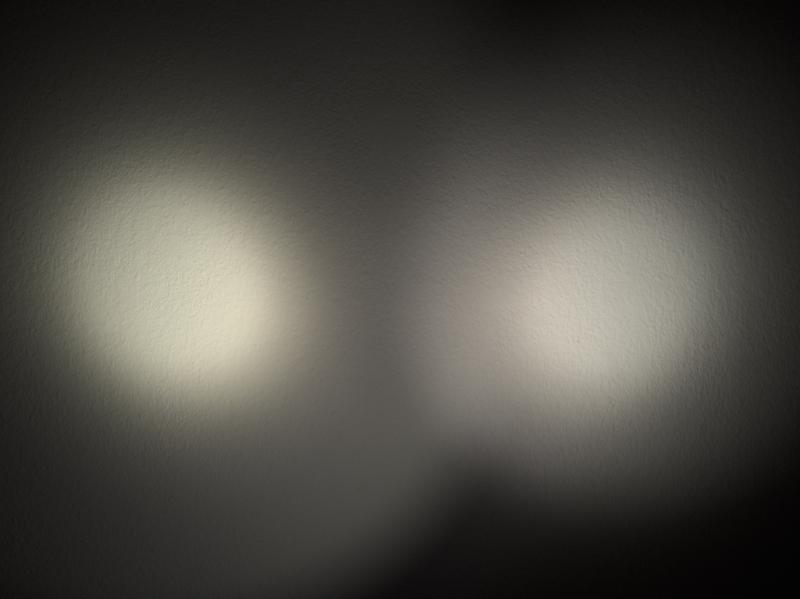
vs Zebralight SC64c LE (LH351D 4000K)
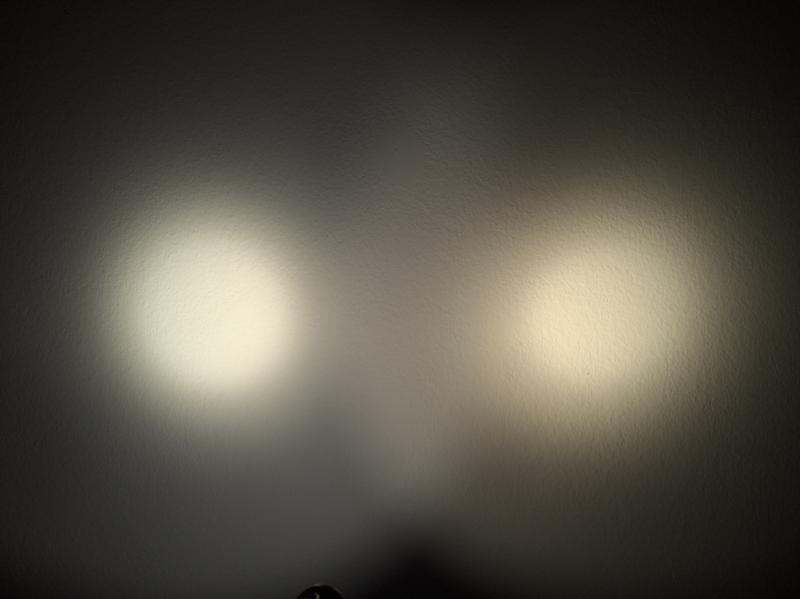
vs Armytek Wizard Pro Nichia (144A 4500K)
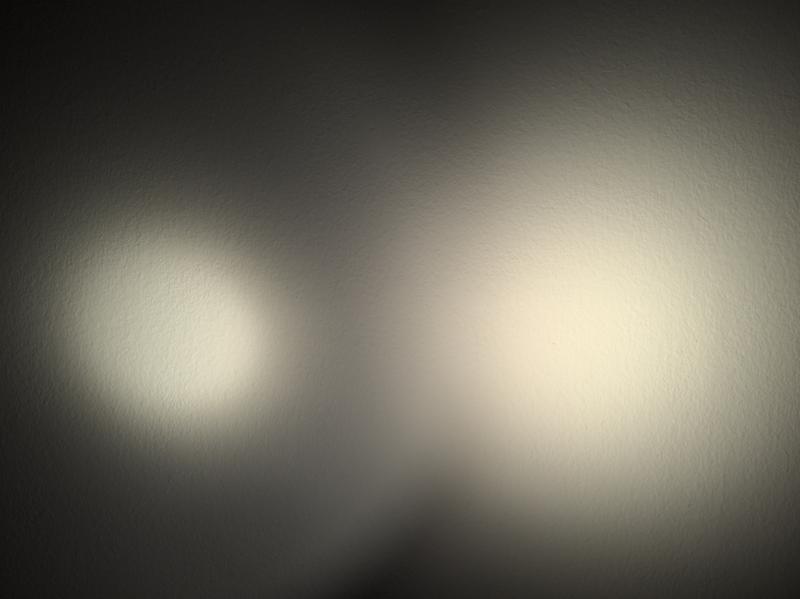
Outdoor

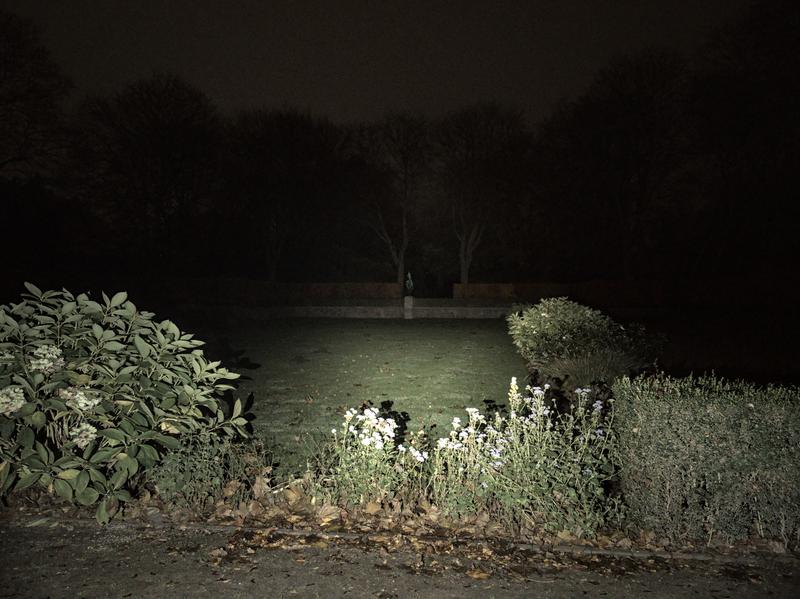
Construction
The M150 shows no issues in its construction with good fit and reasonable tolerances. It survives immersion in water with no signs of ingress. The threads work reliably, but aren't as smooth as some of its competition.
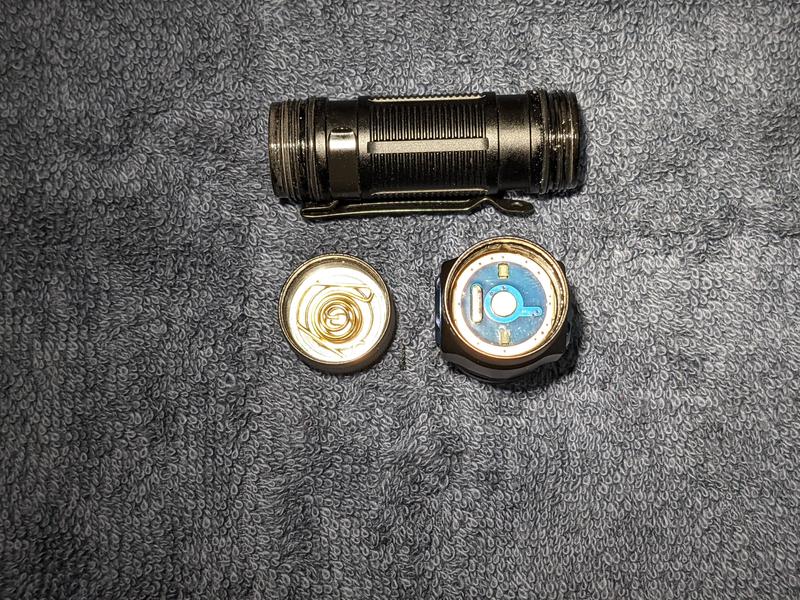
The magnet in the tailcap is removable, but unlike 18650 Skilhunts, the M150 does not include a rubber spacer to replace it.
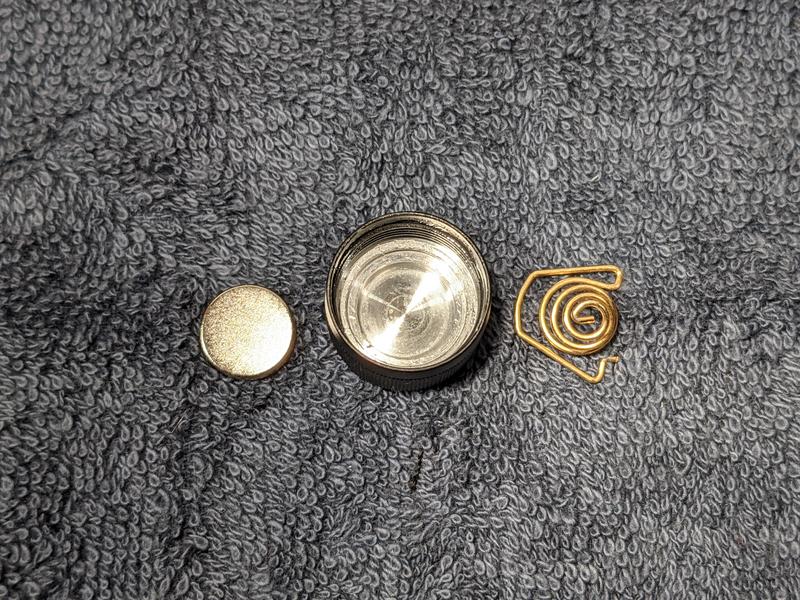
Ergonomics
The M150 is a slim light that's comfortable in the hand and pocket. The charging pad and switch are both raised relative to the rest of the body and easy to find by feel, even with gloves on. It's not necessarily easy to tell the switch and charging pad apart, but squeezing the two between thumb and forefinger reliably actuates the switch. The switch is recessed slightly below its bezel such that contact with a flat surface cannot press it, but actuation force is light and a soft or protruding surface can activate it fairly easily. This has only happened to me once, but I've read complaints from others.
The texturing on the body provides reliable grip. The pocket clip holds the light securely in the pocket and allows easy insertion and removal. It does not, however allow thicker pocket material into the loopover area, making it carry a little shallower than it appears in some pants.
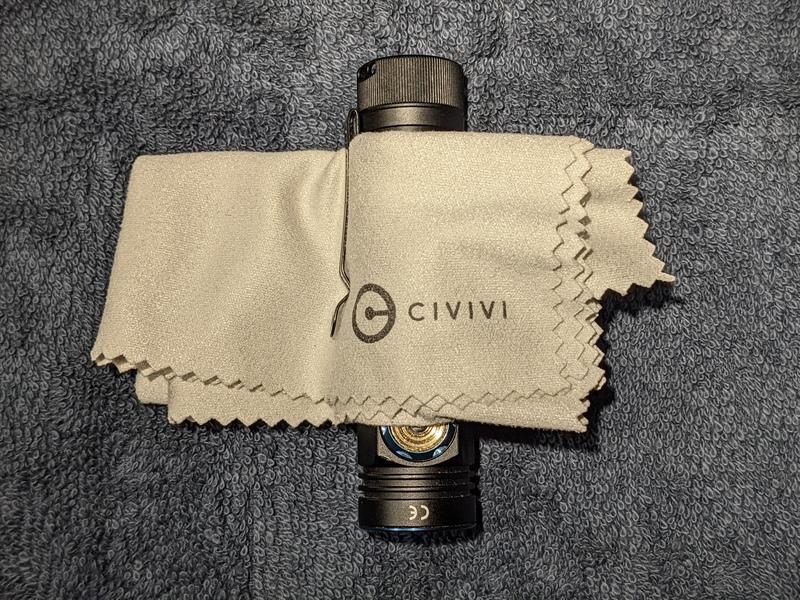
Batteries and charging
The M150 can run on a 14500 Li-ion rechargeable, of which an 800 mAh example is included, AA NiMH rechargeable, AA alkaline disposable, or AA lithium disposable. The 14500 may be charged internally with a USB-magnetic connector, which charges at about 0.8A. Fully charging the 14500 takes about 100 minutes. NiMH cannot be charged internally.
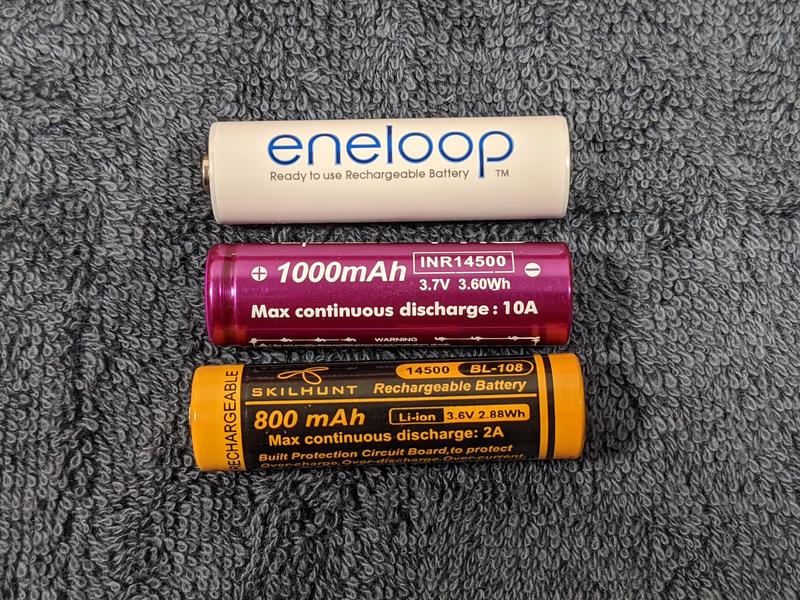
Using the included 14500 to power a slot powerbank to charge a third-party 14500 in the light as seen here is one of the worst ways I can think of to manage portable energy.
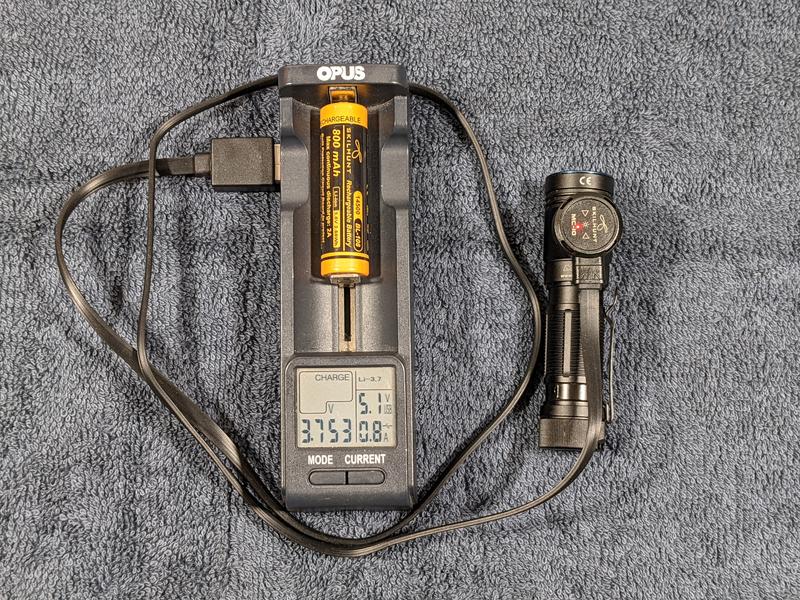
The M150 can run from USB power in all modes without a battery installed or the body of the light attached. What is seen here is again, probably not the best way to use these components.
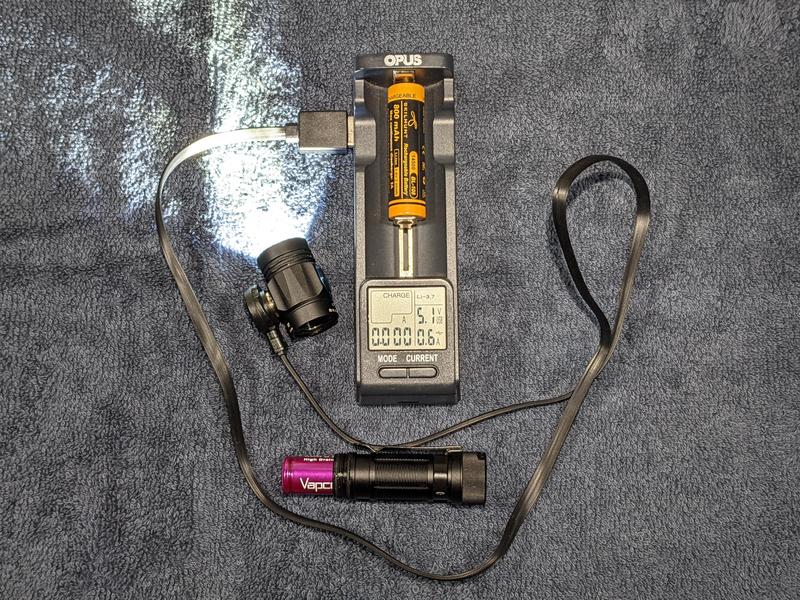
Modification potential
An LED or optic swap in the M150 would be easy, as the bezel simply unscrews with no fuss, glue, or prying. The rectangular MCPCB is the only odd bit, making reflowing another 3535 size LED the easist option. LEDs like the Nichia 219B and Luminus SST-20 would work well in the M150.
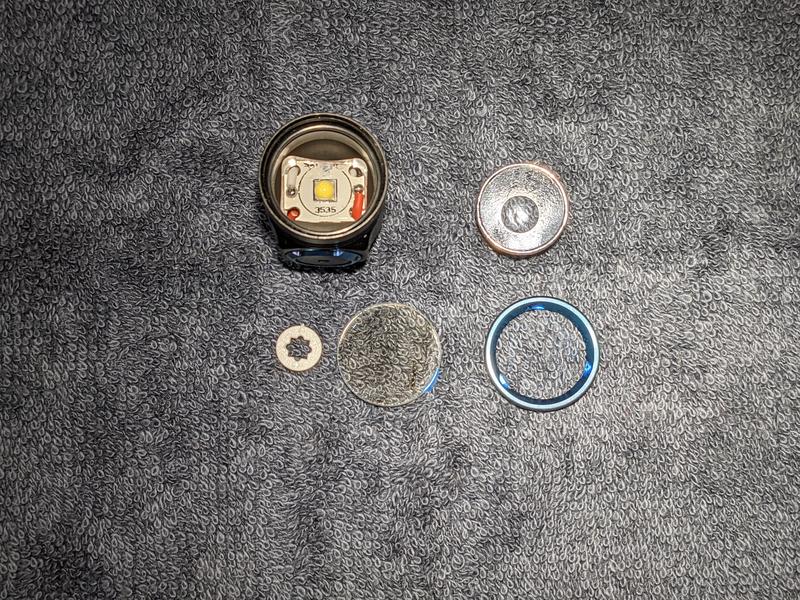
Comments
You can use your Mastodon account to reply to this
Reply
Loading...